|
- Publication date: november 1, 2015 (last update: may 23, 2017) - Hand chart: 12 hand signs in
|
|
|
is available HERE
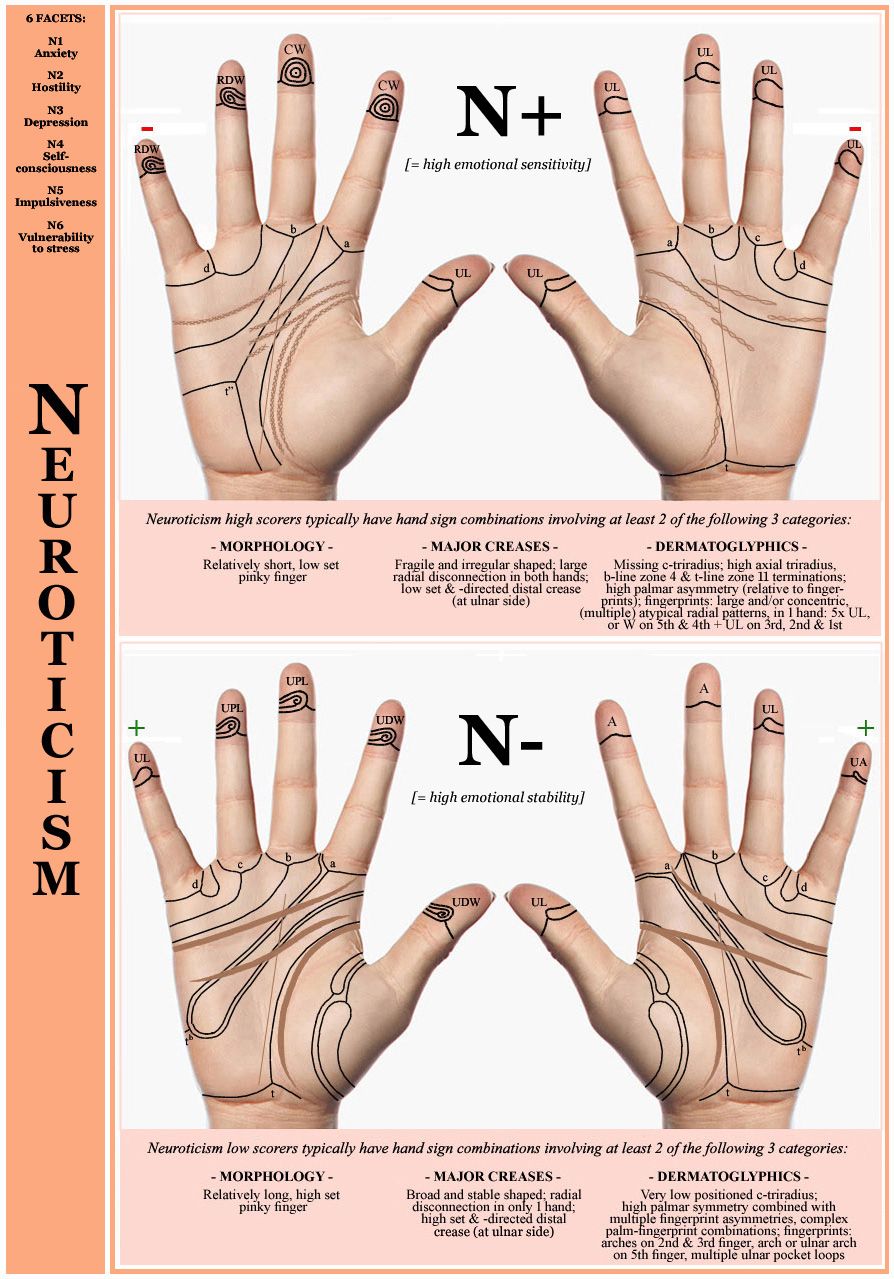
a phantom pictures chart for the hand in introversion & extraversion is available HERE.
The significance of 12 hand factors for
the Big Five personality dimension Neuroticism
And in the last paragraph a report is presented involving the results for the 12 hand factors combined, including a formula describing the weight of individual assessment scores for each of the 12 hand factors.
• Hand factors 1-6 involve various aspects of the 3 primary lines:
- Hand factor 1: path of the heart line (A)
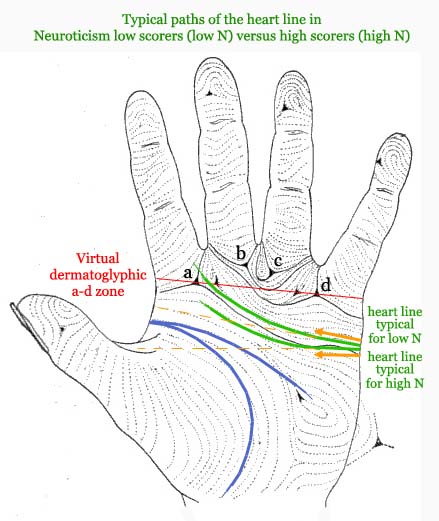 Significance: in about 50% of the high scorers the heart line shows a tendency to follow a 'proximal path' and in 10 out of 34 high scorers this tendency for a 'proximal path' is very strong (a strong 'proximal path' was seen in only 2 out 41 low scorers). In about 75% of the low scorers the heart line shows a tendency to follow a 'distal path' and in 21 out of 41 low scorers this tendency for a 'distal path' is very strong (a strong 'proximal tendency' was seen in only 9 out 34 high scorers). Visual guidelins are presented inside the picture on the right.
Significance: in about 50% of the high scorers the heart line shows a tendency to follow a 'proximal path' and in 10 out of 34 high scorers this tendency for a 'proximal path' is very strong (a strong 'proximal path' was seen in only 2 out 41 low scorers). In about 75% of the low scorers the heart line shows a tendency to follow a 'distal path' and in 21 out of 41 low scorers this tendency for a 'distal path' is very strong (a strong 'proximal tendency' was seen in only 9 out 34 high scorers). Visual guidelins are presented inside the picture on the right.
An additional observation concerns the following: a proximal path of the heart line is also typically seen in simian lines - which are present more commonly in high scorers (11%) than low scorers (3%): interestingly, simian lines featured with an ulnar path directed at the lower side of the upper thenar zone have only been noticed in high scorers (7.4%) and not at all in low scorers (0%). Nevertheless, inside the assessment procedure for the path of the heart line below the presence of a simian line in specific plays no role at all.
Assessment scoring procedure:
The ulnar- and radial part of the heart line are first required to be assessed seperately for each hand, finally the four scores are summarized into a single assessment score.
» Ulnar part of heart line (below pinky finger):
+2 = directed towards the lower half of upper thenar zone [= mount of mars-negative]
+1 = directed towards the upper half of upper thenar zone [= mount mars-negative]
+⅔ = directed towards the life line (requirement: head line and life line have separate radial origins)
+⅓ = directed between the head line and life line (requirement: head line and life line have separate radial origins)
.0 = direct at the origins of the head line and life line (requirement: head line and life line have joined radial origins)
-⅔ = directed towards the head line (requirement: head line and life line have separate radial origins)
-1 = directed above the head line (requirement: head line and life line have joined origins)
-2 = directed above dissociated head line (requirement: head line and life line have separate radial origins)
» Radial part of heart line (below middle/index finger):
+2 = ends far below the 'dermatoglyphic a-d zone'
+1 = ends just below the 'dermatoglyphic a-d zone'
.0 = unclear, or ends very close to the 'dermatoglyphic a-d zone'
-1 = ends just above the 'dermatoglyphic a-d zone'
-2 = ends far above the 'dermatoglyphic a-d zone'
NOTICE: The 'dermatoglyphic a-d zone' (see picture above on right side) refers to the virtual straight path crossing the a-triradius and d-triradius located in the palm just below the fingers - which have been illustrated with the small letters 'a' and 'd'.
- Hand factor 2: radial termination point of the head- & life line (B)
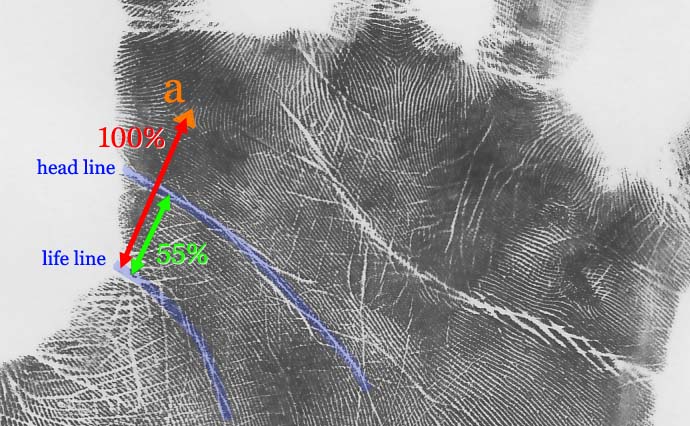 Significance: in 8 out of 34 high scorers (= 23.53%) at least one head line terminates radially at a very large distance from the termination point of the life line - with the distance involving at least 40% of the distance between the life line and the a-triradius. This characteristic is not observed in any of the 41 low scorers (= 0.0%). Nevertheless, in both groups the large majority has a connected radial termination in both hands.
Significance: in 8 out of 34 high scorers (= 23.53%) at least one head line terminates radially at a very large distance from the termination point of the life line - with the distance involving at least 40% of the distance between the life line and the a-triradius. This characteristic is not observed in any of the 41 low scorers (= 0.0%). Nevertheless, in both groups the large majority has a connected radial termination in both hands.
Assessment scoring procedure:
+2 = large disconnection (requirement: distance is larger than 40%)
+1 = smal disconnection (requirement: distance is smaller than 40%)
.0 = unclear
-1 = connected
NOTICE: An earlier study revealed that a dissociated head line has a relatively high prevalence among introverts (+ a relatively low prevalence among extraverts). In general, a dissociated head line often has a higher prevalence in females than in males; studies around the world also indicate that it is relatively common among in Africans and likely less common among Asians.
- Hand factor 3: R-L asymmetry for the radial termination point of the head- & life line (C)
Significance: in 10 out of 41 low scorers (= 24.4%) only one hand has a dissociated head line while in the other hand the head line is connected with the life line - the hands of one of these low scorers is presented in the picture below. R-L asymmetry is observed in only 1 out of 34 high scorers (= 2.9%).
Assessment scoring procedure:
.0 = no R-L asymmetry for dissociated head line
-1 = R-L asymmetry for dissociated head line
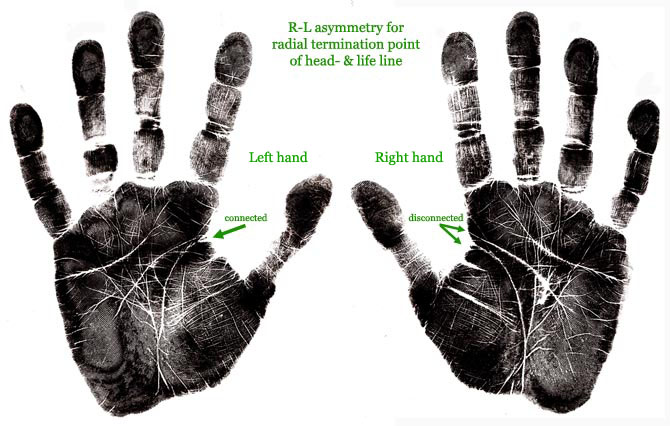
- Hand factor 4: length of the heart- & head line (D)
Significance: in about 18 out of 41 low scorers (= 43.90%) both the heart- & head line are long in at least one hand + there are no inconsistencies in the other hand, while the same criterium is present in only 2 out of 34 high scorers (= 5.88%). Also, in 3 out of 34 high scorers (= 8.82%) both the heart- and head line are short in at least one hand + there are no inconsistencies in the other hand, while the same criterium is missing in any of the 41 low scorers (= 0.00%).
Assessment scoring procedure:
The length of the heart- & head line are required to be assessed seperately for each hand, finally the four scores are summarized into a single assessment score.
» Length of the heart line [upper transverse crease]:
+2 = doesn't clearly pass beyond mid-axis middle finger
+1½ = assessment between score +1 and score +2
+1 = doesn't clearly reach the vertical zone between a-triradius & b-triradius nor the central zone between mid-axes of index- & middle finger
+½ = assessment between score 0 and score +1
.0 = unclear, or ends near the vertical zone between a-triradius & b-triradius + near the central zone between mid-axes of index- & middle finger
-½ = assessment between score -1 and score 0
-1 = ends close the vertical zone of a-triradius and close to mid-axis index finger
-1½ = assessment between score -2 and score -1
-2 = clearly passes beyond the vertical zone of a-triradius and beyond mid-axis index finger
![Assessment scores for the length of the heart line [upper transverse crease].](http://www.handresearch.com/diagnostics/neuroticism/heart-line-length-assessment-scores.jpg)
» Length of the head line [lower transverse crease]:
+2 = doesn't reach mid-axis ring finger & doesn't reach the vertical zone of c-triradius
+1½ = assessment between score +1 and score +2
+1 = ends just beyond mid-axis ring finger & close to the vertical zone of c-triradius
+½ = assessment between score 0 and score +1
.0 = unclear, or ends near mid-axis pinky finger & ends near the vertical zone between c-triradius & d-triradius
-½ = assessment between score -1 and score 0
-1 = ends close to mid-axis pinky finger, but not beyond the vertical zone of d-triradius
-1½ = assessment between score -2 and score -1
-2 = clearly passes beyond mid-axis pinky finger & ends clearly beyond the vertical zone of d-triradius
![Assessment scores for the length of the head line [lower transverse crease].](http://www.handresearch.com/diagnostics/neuroticism/head-line-length-assessment-scores.jpg)
- Hand factor 5: structure & stability of the 3 primary lines (E)
Significance: poor structure combined with poor stability in at least one single hand is found in 6 of the 34 high scorers (= 17.65%) versus none of the 41 low scorers (= 0.0%), while solid structure combined with solid stability in at least one single hand is found in 5 out of 41 low scorers (= 12.20%) versus none of the 34 high scorers (= 0.0%).
Assessment scoring procedure:
Structure & stability of the primary lines are first required to be assessed seperately for each hand, finally the four scores are summarized into a single assessment score.
» Overall structure of the 3 primary lines:
+1 = course structure present in most parts of all 3 individual primary lines
+½ = consistent tendencies towards course structure in some parts of the 3 primary lines
.0 = average structure of the 3 individual primary lines is normal
-½ = consistent tendencies towards fine structure in some parts of the 3 primary lines
-1 = fine structure present in most parts of all 3 individual primary lines
» Overall stability of the 3 primary lines:
+1 = stable morphology present in most parts of all 3 individual primary lines
+½ = consistent tendencies towards stable morphology in some parts of the 3 primary lines
.0 = average stability of the 3 individual primary lines
-½ = consistent tendencies towards unstable morphology in some parts of the 3 primary lines
-1 = unstable morphology present in most parts of all 3 individual primary lines
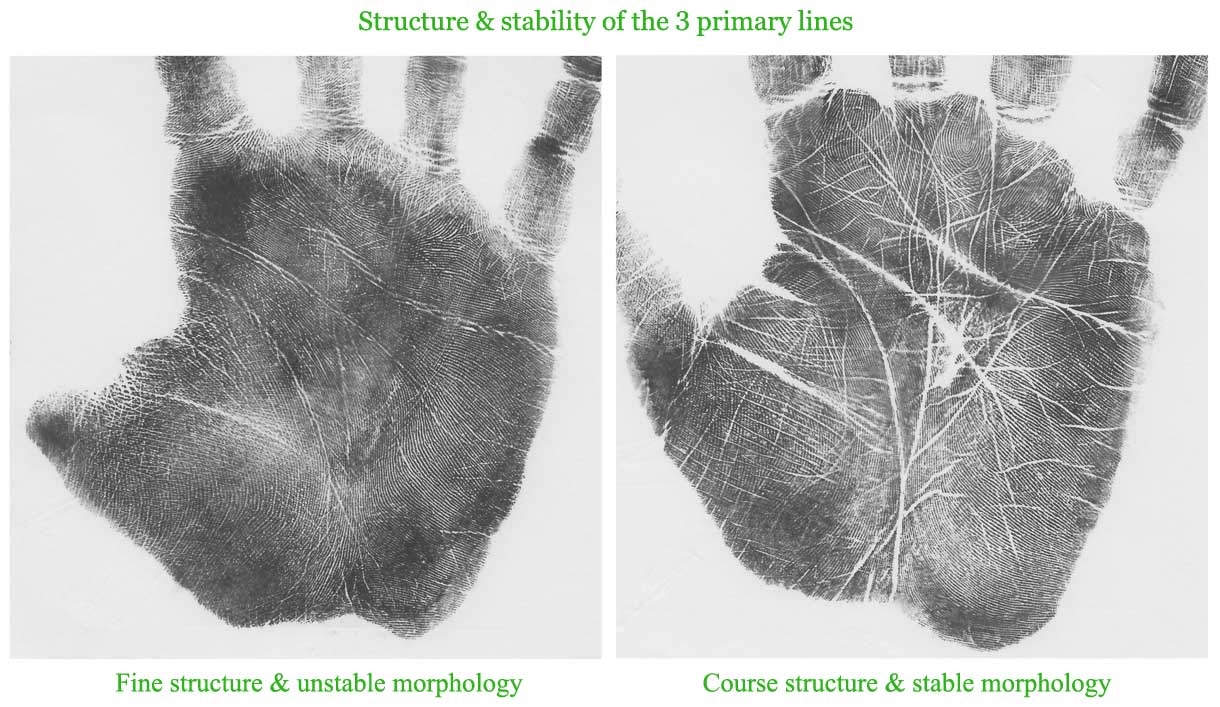
- Hand factor 6: path of the 3 primary lines (F)
Significance: the presence of a normal path of all 3 primary lines is present in 79 out of the 82 hands of the lower scorers (= 96.34%); however, this characterist is only present in 50 out of the 68 hand of the high scorers (73.53%). This indicates that significant abnormalities inside at least one of the primary palmar creases are about 5 times more common among high scorers (compared to low scorers).
Assessment scoring procedure:
The presence of an abnormal path of the 3 primary lines is indicated by the presence of one of the following 4 characteristics (+ a report describing in how many hands each characteristics has been observed):
Hand factor 6a - simian line (high scorers: 8x; low scorers: 2x)
Hand factor 6b - heart line: large interruption / double / location unclear (high scorers: 1x; low scorers: 0x)
Hand factor 6c - head line: large interruption / double / location unclear (high scorers: 2x; low scorers: 1x)
Hand factor 6d - life line: large interruption / double / location unclear (high scorers: 9x; low scorers: 1x)
The assessment scorers are:
+2 = abnormal path is present in both hands
+1 = abnormal path is present in one hand
.0 = normal path
NOTICE: The simian line has commonly been associated with quite a few syndromes, diseases & mental disabilities; additionally, also a large interruption inside the heart line has incidently been associated with mental disorders (such as schizophrenia).
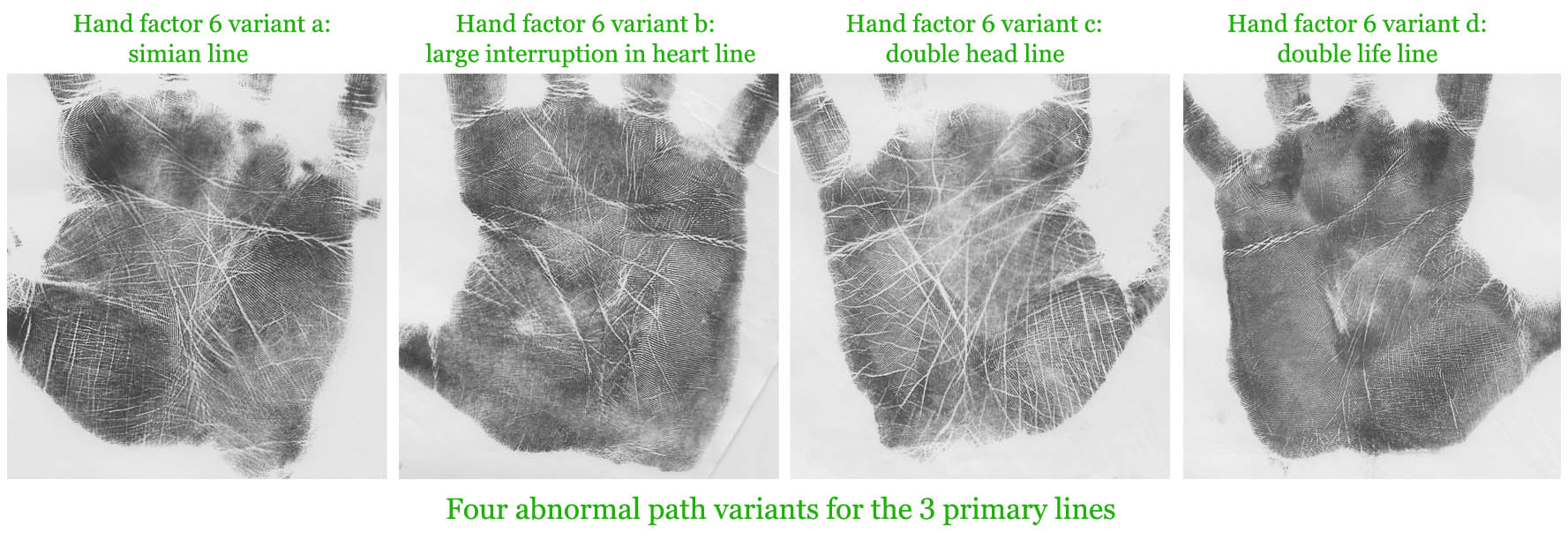
• Hand factors 7-11 involve various aspects of the dermatoglyphics:
- Hand factor 7: arches on both the 2nd & 3rd finger (G)
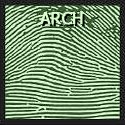 Significance: arches on the 2nd & 3rd finger are present in 8 out of the 41 low scorers (= 19.5%), the combination was not present in any of the 34 high scorers (= 0.0%).
Significance: arches on the 2nd & 3rd finger are present in 8 out of the 41 low scorers (= 19.5%), the combination was not present in any of the 34 high scorers (= 0.0%).
Assessment scoring procedure:
.0 = combination is missing
-1 = combination is present in one hand
-2 = combination is present in both hands
NOTICE: A more detailed evaluation of fingerprints is presented in the article: Fingerprints & Behavior; the diagnostic significance of arches is also described inside the article: 10 facts about arch fingerprints.
- Hand factor 8: c-triradius is missing (H)
Significance: a missing c triradius (see picture below) is present in 4 out of the 34 high scorers (twice in both hands + twice in a single hand = 8.82%), and in 1 out of the 41 low scorers (in a single hand = 1.22%).
Assessment scoring procedure:
+2 = missing c triradius in both hands
+1 = missing c triradius in a single hand
.0 = missing c triradius is not present
NOTICE: A missing c triradius has also been reported to have diagnostic significance for other types of behavior such as introversion [see phantom picture describing hand signs in introverts], schizophrenia [hand sign 8-8], anorexia nervosa & self-injury risk. However, a missing c triradius may also have significance for diseases like for example diabetes mellitus [hand sign 5-4], plus quite a few genetic syndromes, including: Down syndrome [hand sign 8-7] & fragile-X syndrome [hand sign 8-7].
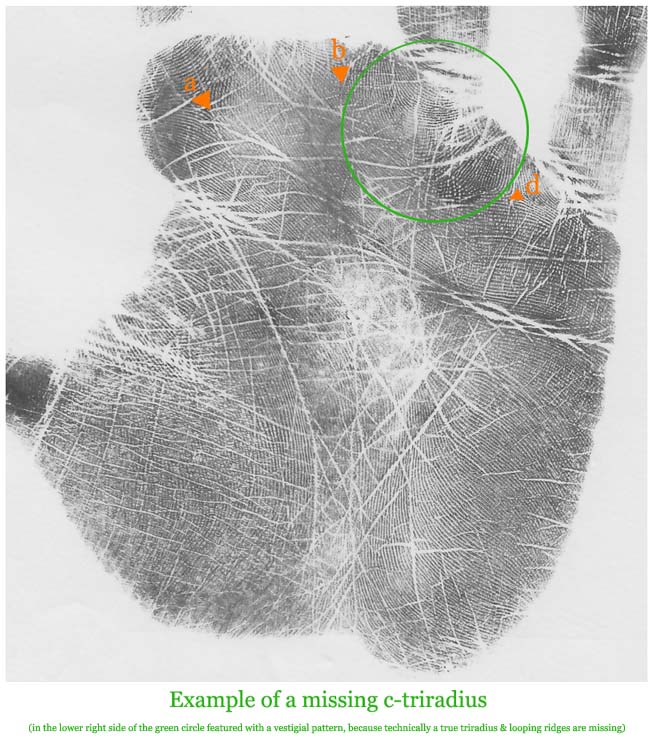
- Hand factor 9: triradius below ring finger is dislocated proximally (I)
Significance: a proximally dislocated triradius below the ring finger (see pictures below) is present in 3 out of the 41 low scorers in a single hand (= 7.32%), and in none of the 34 low scorers (= 0.0%).
Assessment scoring procedure:
A dislocated triradius below the ring finger requires a position below the virtual dermatoglyphic a-d zone (see left + center examples below), or alternatively a position in the lower half between the virtual dermatoglyphic b-d zone and a-d zone (see right example below). It typically manifests as a c-triradius (see the right and the left example below), but sometimes as a d'-triradius (see the center example below).
The assessment scorers are:
.0 = no dislocation, or c-triradius may be missing
-1 = triradius below ring finger is dislocated proximally (requirement: there is no higher positioned triradius below the ring finger)
NOTICE: In general, in far most people the c-triradius below the ring finger is usually in both hands located well above the virtual dermatoglyphic b-d zone.
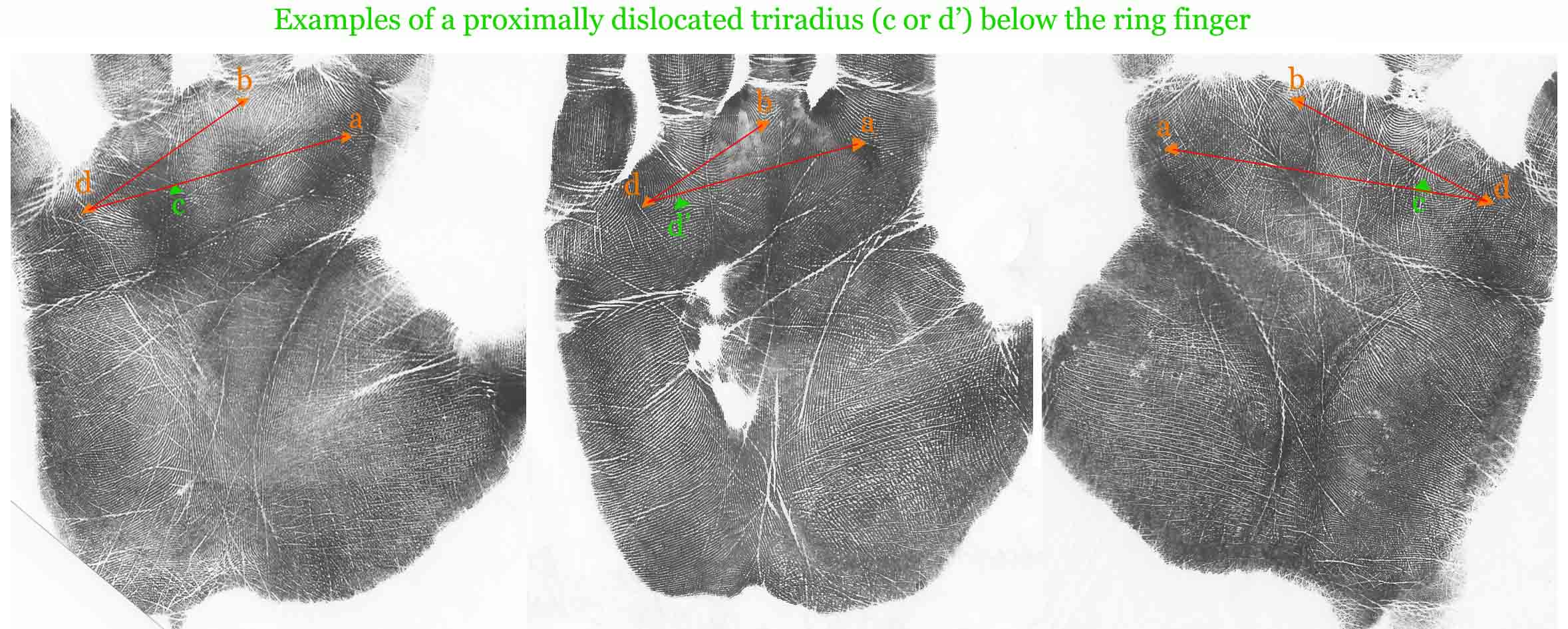
- Hand factor 10: complex dermatoglyphic finger-palm combination (J)
Significance: in 3 out of 41 low scorers (= 7.3%) a complex dermatoglyphic combination is noticed, featured with a loop on both the upper- and lower thenar [= mounts of mars-negative & venus], a loop on the hypothenar [= mount of moon], plus a double loop on one of the fingertips - the hands of one of these low scorers is presented in the picture below. None of the high scorers (= 0.0%) has this combination.
Assessment scoring procedure:
.0 = finger-palm combination is missing
-1 = finger-palm combination is present in one hand
-2 = finger-palm combination is present in both hands
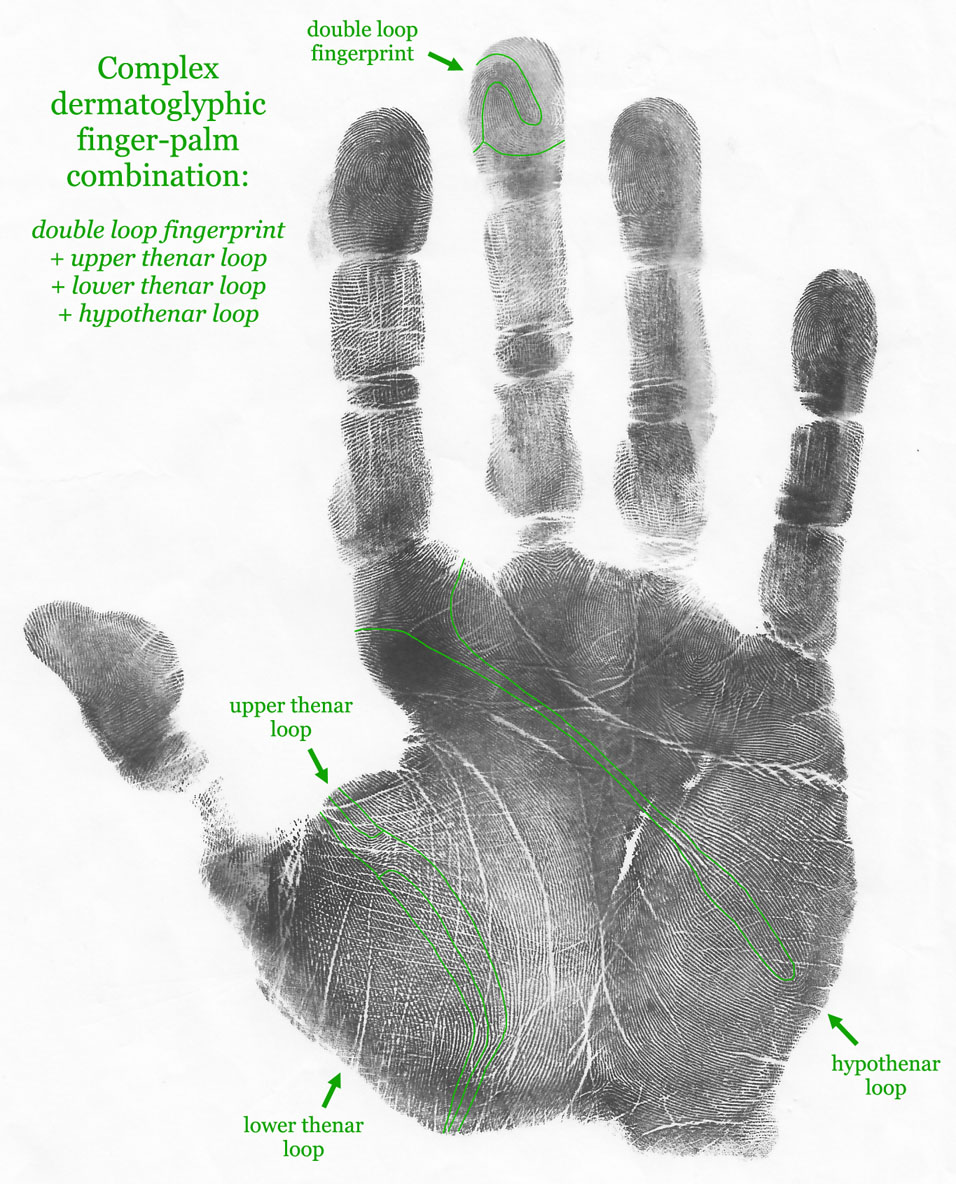
- Hand factor 11: dermatoglyphic asymmetries (K)
Significance: very low levels of dermatoglyphic asymmetry have been observed in 4 out of 41 low scorers (= 9.76%) versus 0 out of 34 high scorers (= 0.0%); however, the most significant manifestation was found in a group of 10 out of 41 low scorers (= 24.39%) where multiple fingers exhibit dermatoglyphic pattern asymmetry combined with relatively small amount of dermatoglyphic asymmetries in the palm - this combination was not found in any of the 34 high scorers (= 0.0%). Additionally, in almost half of the high scorers various combinations reflecting a relatively high amount of palmar asymmetries were found that are not presentamong any of the low scorers.
Assessment scoring procedure:
The factor involving dermatoglyphic asymmetries has been assessed via a comparison of 5 aspects between both hands:
Hand factor 11a - total amount of fingerprint triradii in digit 2, 3, 4 & 5
Hand factor 11b - total amount of fingerprint asymmetries in digit 2, 3, 4 & 5
Hand factor 11c - total amount of palmar triradii
Hand factor 11d - total amount of palmar pattern asymmetries
Hand factor 11e - total amount of main line asymmetries (involving dermatoglyphic lines inward progressing from triradii a, b, c, d & t)
Hand factor 11f - position of the highest positioned axial triradiu (in the hypothenar zone)
Two signficant combinations representing low amounts of dermatoglyphic asymmetry have been observed among the low scorers:
1A) factor 11a + 11b is at least +2 combined with factor 11c + 11d + 11e + 11f < 11a + 11b (low scorers: 10x, high scorers: 0x)
1B) no asymmetries for factor 11a & 11b combined with a total summarized score of maximum +1 for factor 11c + 11d + 11e + 11f (low scorers: 4x, high scorers: 0x)
Six signficant combinations representing relatively high amounts of palmar dermatoglyphic asymmetry have been observed among the high scorers:
2A) factor 11e ⩾ +4 (high scorers: 6x, low scorers: 0x)
2B) factor 11d + 11e ⩾ +5 (high scorers: 5x, low scorers: 0x)
2C) distal dermatoglyphic line ends in just one hand between interdigital zone 11 [= between index & middle finger] (high scorers: 5x, low scorers: 0x)
2D) factor 11a + 11b < 11c + 11d + 11e + 11f combined with factor 11d > 0 and factor 11e > 0 and factor 11f > 0 (high scorers: 5x, low scorers: 0x)
2E) factor 11b + 11d ⩾ +4 combined with factor 11a + 11b - 11c - 11d - 11e - 11f ⩾ -1 (high scorers: 4x, low scorers: 0x)
2F) factor 11c + 11d + 11e ⩾ 5.5 (high scorers: 3x, low scorers: 0x)
The assessment scores are for hand factor 11 are:
+1 = at least one of the combinations 2a, 2b, 2c, 2d, 2e or 2f is present
.0 = all eight combination variants are missing
-1 = combination 1a and/or 1b is present
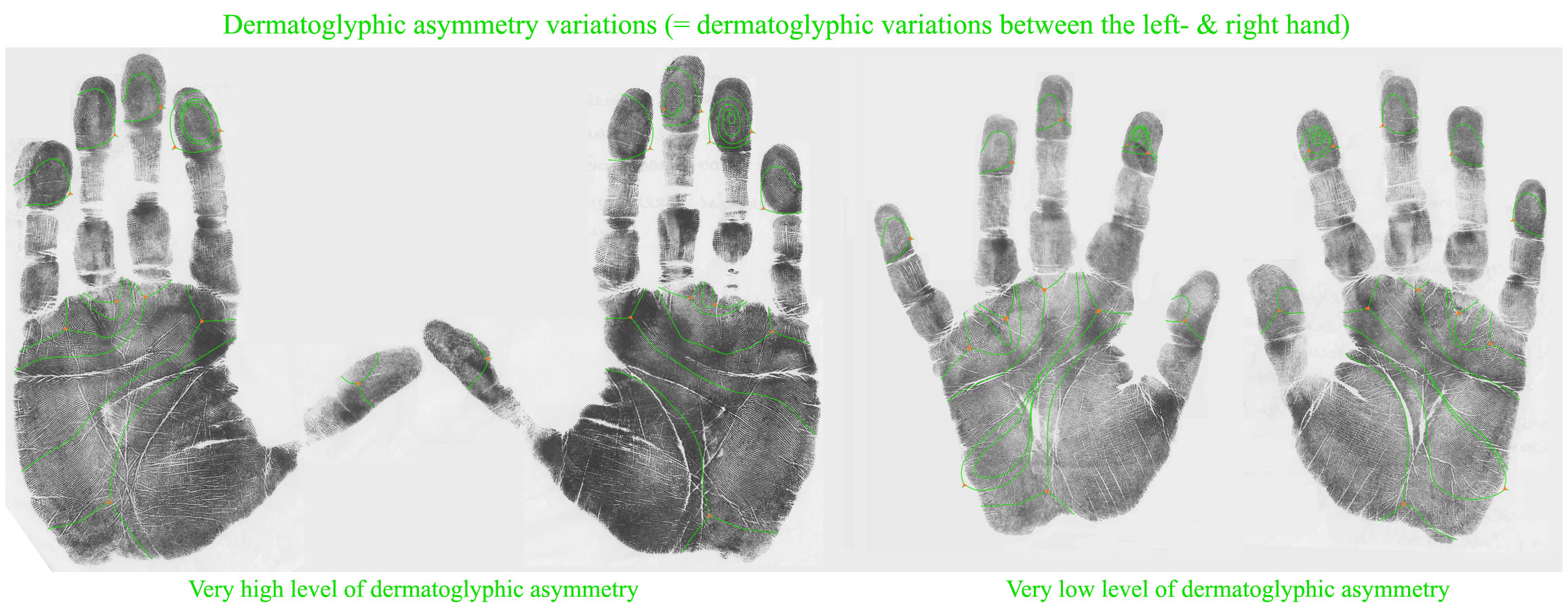
• The final 12th hand factor involves the pinky finger:
- Hand factor 12: overall development of the pinky finger (L)
Significance: a consistent strong development of the pinky finger is more often present in low scorers (18 out of 41 = 43.90%) compared to high scorers (9 out of 34 = 26.47%), while a consistent weak development of the pinky finger is more often present in high scorers (17 out of 34 = 50.00%) compared to low scorers (11 out of 41 = 26.83%).
Assessment scoring procedure:
The development of the pinky finger is required to be assessed for each hand separately in terms of absolute length and relative length development; finally the four scores are summarized into a single assessment score.
» Absolute length of the pinky finger:
Measurements have been made for the absolute length of the pinky finger relative the absolute length of the middle finger; measurements have also been made for the distance between the accessory palmar triradius (d) to the tip of the pinky finger relative to the distance between the accessory palmar triradius (b) to the tip of the middle finger.
+1 = average value < 0.74
.0 = average value between 0.74 and 0.795
-1 = average value > 0.795
» Relative development of the pinky finger:
Assessment have been made for the relative length of the pinky finger in 3 perspectives: (A) length development relative to the upper interphalangeal crease of the ring finger, (B) length development relative to the first 2 phalanges of the middle finger, and (C) the setting of the pinky finger relative to the zone between the radial termination point of the life line and the setting of the index finger.
NOTICE: Due to the complexity involved with the assessment of the individual aspects A, B & C, for convenience not all details are published here necessary for making a precise assessment for the relative development of the pink finger.
+1 = total assessment score ⩽ 0.5
+½ = total assessment score between > 0.5 and ⩽ 2.5
.0 = total assessment score between 2.5 and < 7.5
-½ = total assessment score between ⩾ 7.5 and < 9.5
-1 = total assessment score ⩾ 9.5
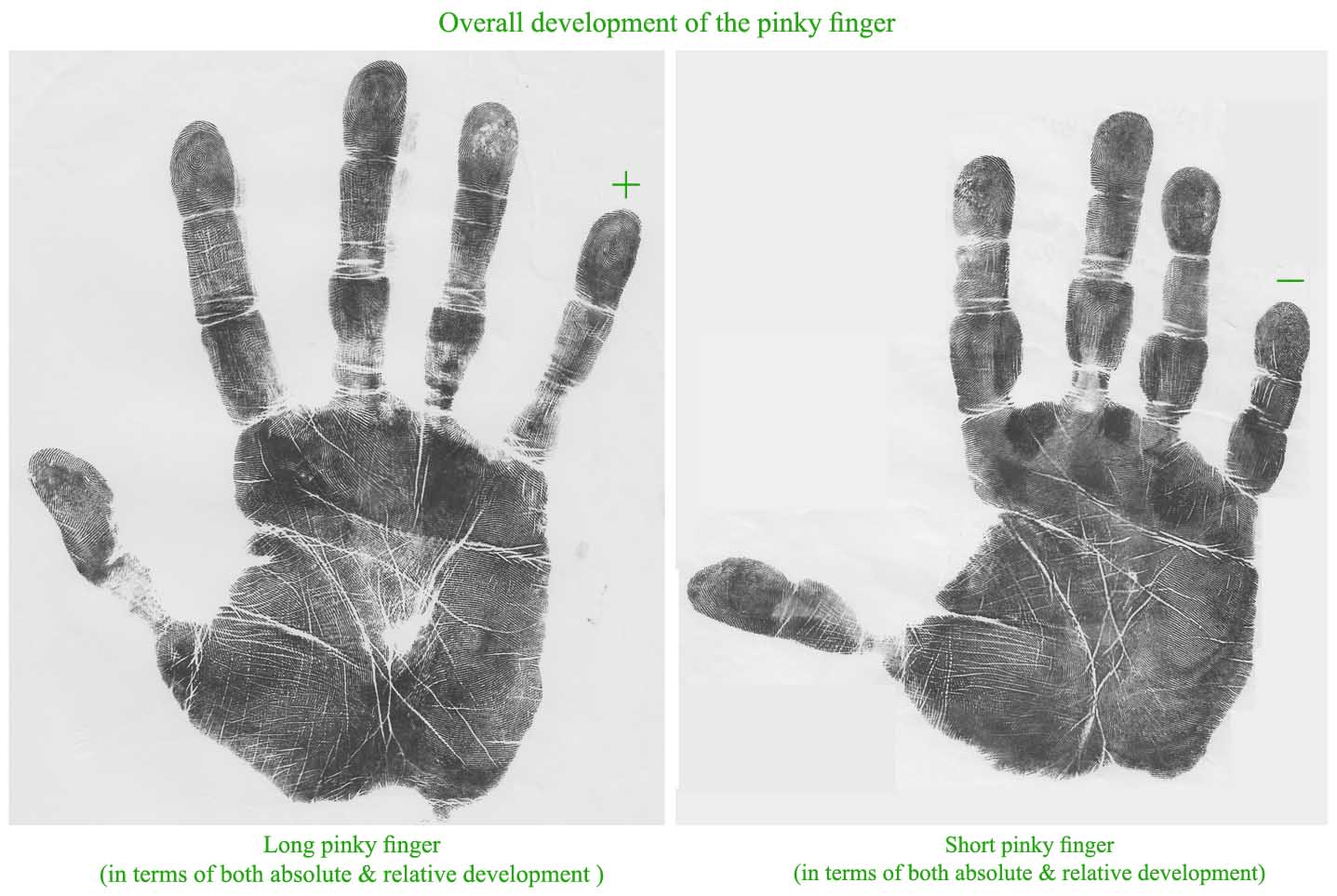
The results for the 12 hand factors combined!
100% success-score based on 12 hand factors
|
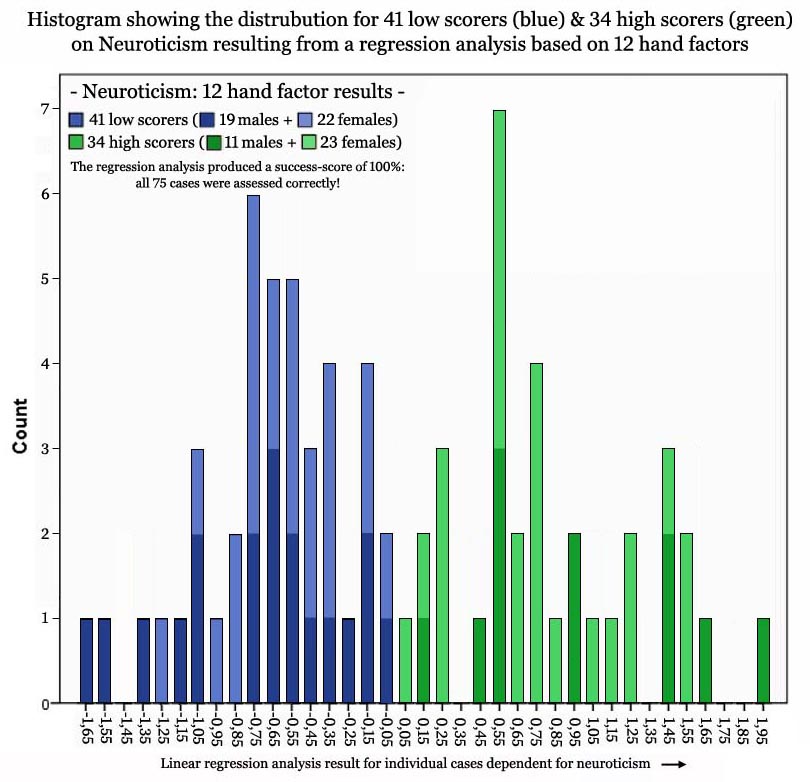
|
Linear regression analysis result for NEUROTICISM = 0,309 + (0,038 x A) + (0,088 x B) + (0,523 x C) + (0,0315 x D) + (0,211 x E) + (0,105 x F) + (0,142 x G) + (0,263 x H) + (0,827 x I) + (0,369 x J) + (0,584 x K) + (0,249 x L)
A = hand factor 1: path of the heart line [sign. = 0.071];
B = hand factor 2: radial termination point of the head- & life line [sign. = 0.023];
C = hand factor 3: R-L asymmetry for the radial termination point of the head- & life line [sign. = 0.013];
D = hand factor 4: length of the heart- & head line [sign. = 0.045];
E = hand factor 5: structure & stability of the 3 primary lines [sign. = 0.001];
F = hand factor 6: path of the 3 primary lines [sign. = 0.738];
G = hand factor 7: arches on both the 2nd & 3rd finger [sign. = 0.227];
H = hand factor 8: c-triradius is missing [sign. = 0.154];
I = hand factor 9: triradius below ring finger is dislocated proximally [sign. = 0.026];
J = hand factor 10: complex dermatoglyphic finger-palm combination [sign. = 0.134];
K = hand factor 11: dermatoglyphic asymmetries [sign. = 0.000];
L = hand factor 12: overall development of the pinky finger [sign. = 0.001].
NOTICE: sig. describes the level of significance for each individual hand factor. It is especially interesting to notice that the details indicate that the 2 hand factors that involve considerations of asymmetry have a relatively high weight in the result (with opposite effects between the dermatoglyphis and the radial termination points of the head- & life line); additionally, high weight is also observed for the pinky finger + the structure & stability of the primary lines.
The table below describes the data pool that produced the results presented above for the neuroticism (= high scores) versus emotional stability (low scorers); the data signals that regarding the Big Five personality dimension Neuroticism most people display a mix of what appear to be 'inconsistent' hand signs, since in only 19 out of 75 subjects involved with this study the variation can be described as relatively 'consistent':
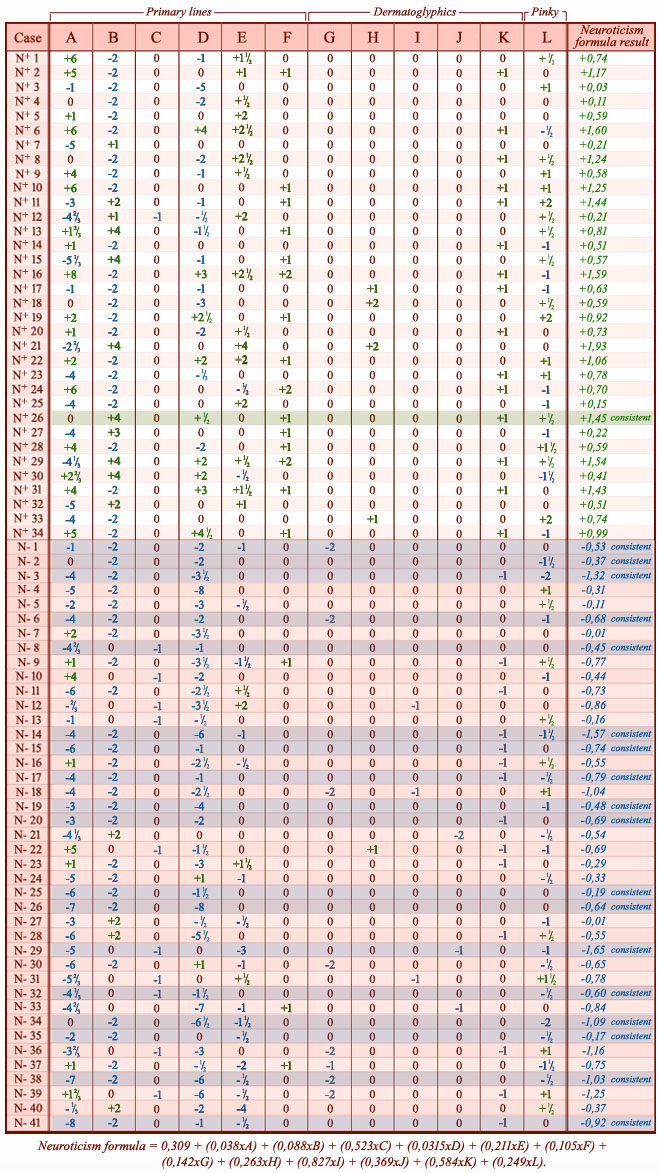
constellations between the dermatoglyphics & primary creases a new analysis revealed a
relatively high occurrence of radial loops & radial whorls in Neuroticism high scorers (see radial loop fact 8).
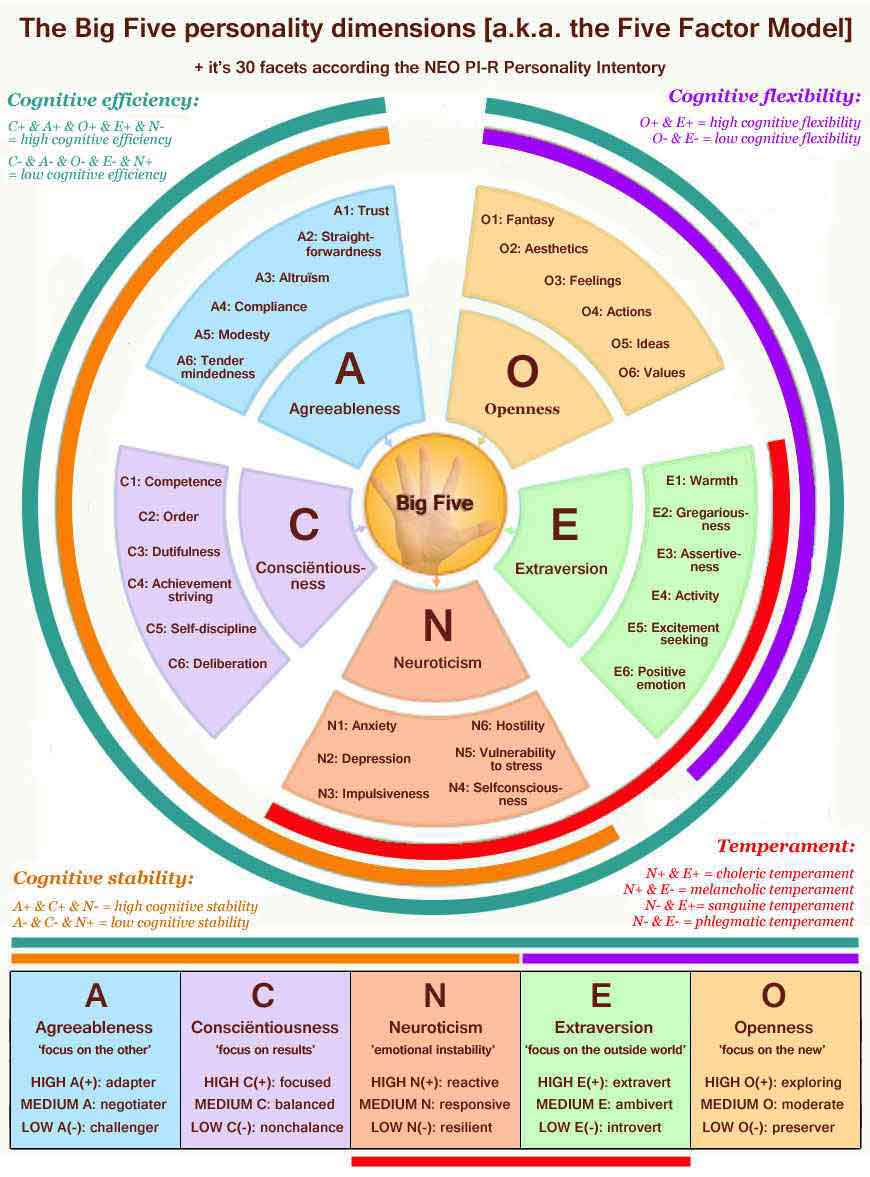
Neuroticism represent a dimension of the Big Five model, a.k.a. the 'Five Factor Model' (FFM).
The model is designed to describe the full 'color-spectrum' of a personality, including:
the classic temperaments, cognitive stability & cognitive flexibility.
Final notification: case studies will become available in the near future; meanwhile you might want to explore
the other four Big Five dimensions Agreeableness, Conscientiousness, Extraversion & Openness!
All Big Five hand charts are presented together inside the article:
Hand sign constellations in the Big Five personality dimensions.
|
|
© COPYRIGHT 2002-2017: |